
Rowing, sometimes called crew in the United States, is the sport of racing boats using oars. It differs from paddling sports in that rowing oars are attached to the boat using oarlocks, while paddles are not connected to the boat. Rowing is divided into two disciplines: sculling and sweep rowing. In sculling, each rower holds two oars—one in each hand, while in sweep rowing each rower holds one oar with both hands. There are several boat classes in which athletes may compete, ranging from single sculls, occupied by one person, to shells with eight rowers and a coxswain, called eights. There are a wide variety of course types and formats of racing, but most elite and championship level racing is conducted on calm water courses 2 kilometres (1.2 mi) long with several lanes marked using buoys.

James Bruce Tomkins, is an Australian rower, seven-time World Champion and a three-time Olympic gold medalist. He is Australia's most awarded oarsman, having made appearances at six Olympic games ; eleven World Championships ; four Rowing World Cups and eighteen state representative King's Cup appearances – the Australian blue riband men's VIII event,. Tomkins is one of only five Australian athletes and four rowers worldwide to compete at six Olympics. From 1990 to 1998 he was the stroke of Australia's prominent world class crew – the coxless four known as the Oarsome Foursome.
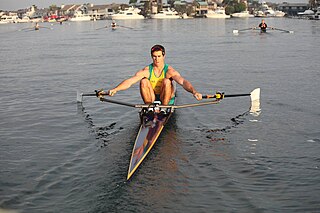
Sculling is the use of oars to propel a boat by moving them through the water on both sides of the craft, or moving one oar over the stern. A long, narrow boat with sliding seats, rigged with two oars per rower may be referred to as a scull, its oars may be referred to as sculls and a person rowing it referred to as sculler.

Rowing is the act of propelling a human-powered watercraft using the sweeping motions of oars to displace water and generate reactional propulsion. Rowing is functionally similar to paddling, but rowing requires oars to be mechanically attached to the boat, and the rower drives the oar like a lever, exerting force in the same direction as the boat's travel; while paddles are completely hand-held and have no attachment to the boat, and are driven like a cantilever, exerting force opposite to the intended direction of the boat.

In watercraft, a racing shell is an extremely narrow, and often comparatively long, rowing boat specifically designed for racing or exercise. It is outfitted with long oars, outriggers to hold the oarlocks away from the boat, and sliding seats. The boat's long length and semicircular cross-section reduce drag to a minimum. This makes the boat both fast and unstable. It must be balanced by the rowers to avoid tipping. Being able to balance – or "set" – the boat while putting maximum effort into the oars is therefore an essential skill of sport rowing.
In competitive rowing, the following specialized terms are important in the corresponding aspects of the sport:

In a rowing crew, the coxswain is the member who does not row but steers the boat and faces forward, towards the bow. The coxswain is responsible for steering the boat and coordinating the power and rhythm of the rowers. In some capacities, the coxswain is responsible for implementing the training regimen or race plan. Most coaches cannot communicate to boat/coxswain, so the coxswain is the "coach" in the boat. A coxswain is necessary in the first place because the rowers sit with their backs to the direction of travel.
In the sport of rowing, each rower is numbered by boat position in ascending order from the bow to the stern. The person who is seated on the first seat is always the 'bow', the closest to the stern is commonly referred to as the 'stroke'. There are some exceptions to this: Rowers in continental Europe number from stern up to bow. Certain crew members have other informal titles and roles. Stroke seat in most cases is responsible for keeping pace for the boat, while the coxswain is responsible for the steering of the boat.

A single scull, also abbreviated as a 1x, is a rowing boat designed for a single person who propels the boat with two oars, one in each hand.

A double scull, also abbreviated as a 2x, is a rowing boat used in the sport of competitive rowing. It is designed for two persons who propel the boat by sculling with two oars each, one in each hand.

A quadruple sculling boat, often simply called a quad and abbreviated 4x, is a rowing boat used in the sport of competitive rowing. It is designed for four people who propel the boat by sculling with two oars, or "sculls", one in each hand.
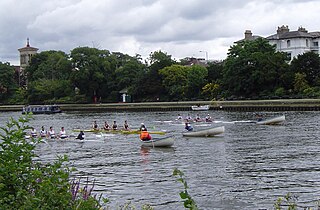
A coxed four, also known as a 4+, is a racing shell used in the sport of competitive rowing. It is designed for four persons who propel the boat with sweep oars and is steered by a coxswain.
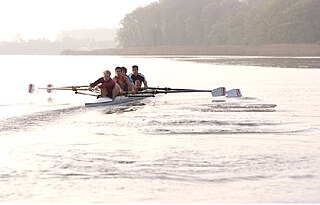
A coxless four, abbreviated as a 4- and also called a straight four, is a racing shell used in the sport of competitive rowing. It is designed for four persons who propel the boat with sweep oars, without a coxswain.

A coxed pair, also known as a 2+, is a rowing boat used in the sport of competitive rowing. It is designed for two persons who propel the boat with sweep oars and is steered by a coxswain.
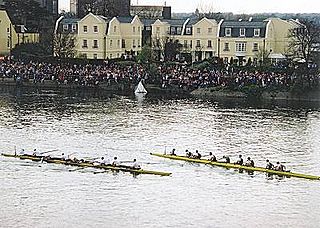
An eight, abbreviated as an 8+, is a racing shell used in the sport of competitive rowing (crew). It is designed for eight rowers, who propel the boat with sweep oars, and is steered by a coxswain, or "cox".

Sweep rowing is one of two disciplines of the sport of rowing. In sweep rowing each rower has one oar, usually held with both hands. As each rower has only one oar, the rowers have to be paired so that there is an oar on each side of the boat. In the United Kingdom, rowing generally refers to sweep rowing only. The term pulling was also used historically. In the other rowing discipline, sculling, each rower holds two oars, one in each hand.
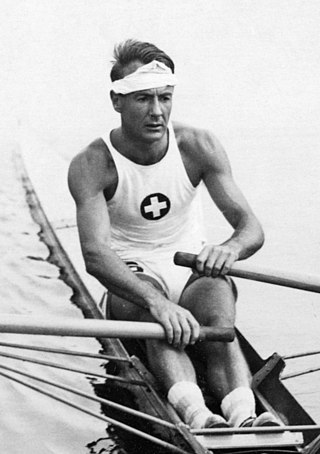
The men's coxed pair event was part of the rowing programme at the 1924 Summer Olympics. The competition, the third appearance of the event, was held from 14 to 17 July 1924 on the river Seine. Five teams, each from a different nation, competed, for a total of 15 rowers and coxswains. The event was won by Switzerland, with rowers Édouard Candeveau and Alfred Felber and coxswain Émile Lachapelle. The two Swiss rowers had earned bronze in 1920 with a different cox. Defending champion Italian rowers Ercole Olgeni and Giovanni Scatturin took silver, this time with Gino Sopracordevole as their cox. Candeveau, Felber, Olgeni, and Scatturin were the first four men with multiple medals in the event. The United States' debut in the event netted a bronze medal for rowers Leon Butler and Harold Wilson and cox Edward Jennings.

An octuple sculling shell, often simply called an oct and abbreviated as an 8x or 8x+, is a racing shell used in the sport of rowing.

The men's coxed pair competition at the 1972 Summer Olympics in Munich took place from 27 August to 2 September at the Olympic Regatta Course in Oberschleißheim. There were 21 boats from 21 nations, with each nation limited to a single boat in the event. The event was won by East German crew Wolfgang Gunkel, Jörg Lucke, and coxswain Klaus-Dieter Neubert; it was the first medal in the event for East Germany as a separate nation. Czechoslovakia (silver) and Romania (bronze) also won their first medals in the men's coxed pair.

The men's coxed pair competition at the 1960 Summer Olympics took place at took place at Lake Albano, Italy. It was held from 31 August to 3 September. There were 18 boats from 18 nations, with each nation limited to a single boat in the event. The three nations on the podium were the same as those in 1956, though in a different order. The event was won by the United Team of Germany, with Bernhard Knubel and Heinz Renneberg rowing with Klaus Zerta the coxswain. Zerta is the youngest confirmed male gold medalist in Olympic history at 13 years and 283 days, just beating Hans Bourquin by 9 days. The 1900 men's coxed pair gold-medal-winning coxswain may have been younger, but the identities and ages of most coxswains in that event, including the gold medalist, are not known. The Soviet Union, bronze in 1956, took silver this time with Antanas Bagdonavičius, Zigmas Jukna, and Igor Rudakov. Defending champions the United States took bronze; Conn Findlay was the only man from the 1956 podium to return, this time with Richard Draeger as his rowing partner and Kent Mitchell the coxswain.



















